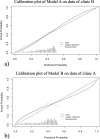Using the embryo-uterus statistical model to predict pregnancy chances by using cleavage stage morphokinetics and female age: two centre-specific prediction models and mutual validation
- PMID: 36973721
- PMCID: PMC10041771
- DOI: 10.1186/s12958-023-01076-8
Using the embryo-uterus statistical model to predict pregnancy chances by using cleavage stage morphokinetics and female age: two centre-specific prediction models and mutual validation
Abstract
Background: The predictive capability of time-lapse monitoring (TLM) selection algorithms is influenced by patient characteristics, type and quality of data included in the analysis and the used statistical methods. Previous studies excluded DET cycles of which only one embryo implanted, introducing bias into the data. Therefore, we wanted to develop a TLM prediction model that is able to predict pregnancy chances after both single- and double embryo transfer (SET and DET).
Methods: This is a retrospective study of couples (n = 1770) undergoing an in vitro fertilization cycle at the Erasmus MC, University Medical Centre Rotterdam (clinic A) or the Reinier de Graaf Hospital (clinic B). This resulted in 2058 transferred embryos with time-lapse and pregnancy outcome information. For each dataset a prediction model was established by using the Embryo-Uterus statistical model with the number of gestational sacs as the outcome variable. This process was followed by cross-validation.
Results: Prediction model A (based on data of clinic A) included female age, t3-t2 and t5-t4, and model B (clinic B) included female age, t2, t3-t2 and t5-t4. Internal validation showed overfitting of model A (calibration slope 0.765 and area under the curve (AUC) 0.60), and minor overfitting of model B (slope 0.915 and AUC 0.65). External validation showed that model A was capable of predicting pregnancy in the dataset of clinic B with an AUC of 0.65 (95% CI: 0.61-0.69; slope 1.223, 95% CI: 0.903-1.561). Model B was less accurate in predicting pregnancy in the dataset of clinic A (AUC 0.60, 95% CI: 0.56-0.65; slope 0.671, 95% CI: 0.422-0.939).
Conclusion: Our study demonstrates a novel approach to the development of a TLM prediction model by applying the EU statistical model. With further development and validation in clinical practice, our prediction model approach can aid in embryo selection and decision making for SET or DET.
Keywords: Embryo transfer; In vitro fertilisation; Prediction model; Statistical models; Time-lapse imaging.
© 2023. The Author(s).
Conflict of interest statement
The authors declare no competing interests.
Figures




Similar articles
-
Individualized decision-making in IVF: calculating the chances of pregnancy.Hum Reprod. 2013 Nov;28(11):2972-80. doi: 10.1093/humrep/det315. Epub 2013 Aug 6. Hum Reprod. 2013. PMID: 23925394
-
Development of a generally applicable morphokinetic algorithm capable of predicting the implantation potential of embryos transferred on Day 3.Hum Reprod. 2016 Oct;31(10):2231-44. doi: 10.1093/humrep/dew188. Epub 2016 Sep 8. Hum Reprod. 2016. PMID: 27609980 Free PMC article.
-
Noninvasive embryo evaluation and selection by time-lapse monitoring vs. conventional morphologic assessment in women undergoing in vitro fertilization/intracytoplasmic sperm injection: a single-center randomized controlled study.Fertil Steril. 2022 Jun;117(6):1203-1212. doi: 10.1016/j.fertnstert.2022.02.015. Epub 2022 Mar 30. Fertil Steril. 2022. PMID: 35367059 Clinical Trial.
-
Guidelines for the number of embryos to transfer following in vitro fertilization No. 182, September 2006.Int J Gynaecol Obstet. 2008 Aug;102(2):203-16. doi: 10.1016/j.ijgo.2008.01.007. Int J Gynaecol Obstet. 2008. PMID: 18773532 Review.
-
Higher probability of live-birth in high, but not normal, responders after first frozen-embryo transfer in a freeze-only cycle strategy compared to fresh-embryo transfer: a meta-analysis.Hum Reprod. 2019 Mar 1;34(3):491-505. doi: 10.1093/humrep/dey388. Hum Reprod. 2019. PMID: 30689865
Cited by
-
Predicting IVF live -birth probability using time-lapse data: Implications of including or excluding age in a day 2 embryo transfer model.PLoS One. 2025 Feb 25;20(2):e0318480. doi: 10.1371/journal.pone.0318480. eCollection 2025. PLoS One. 2025. PMID: 39999051 Free PMC article.
References
MeSH terms
LinkOut - more resources
Full Text Sources

